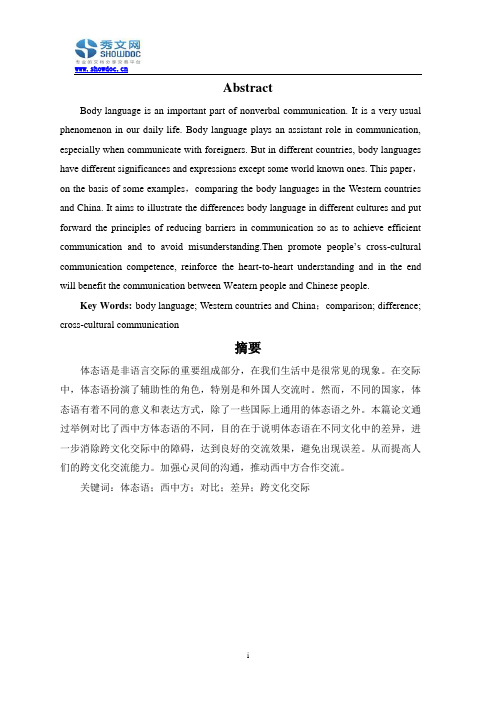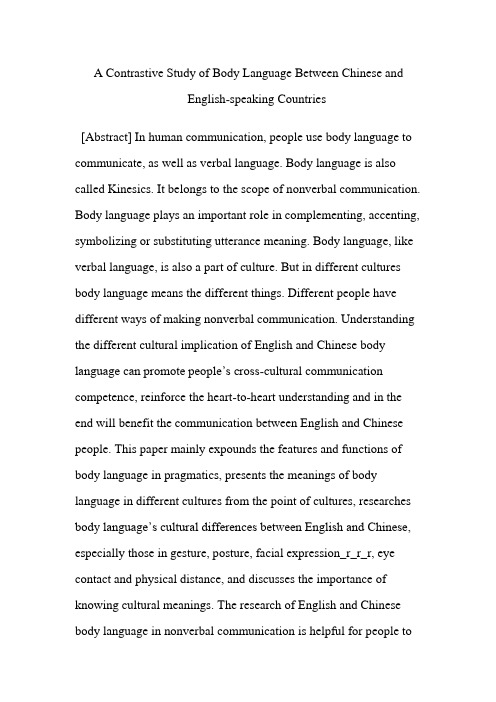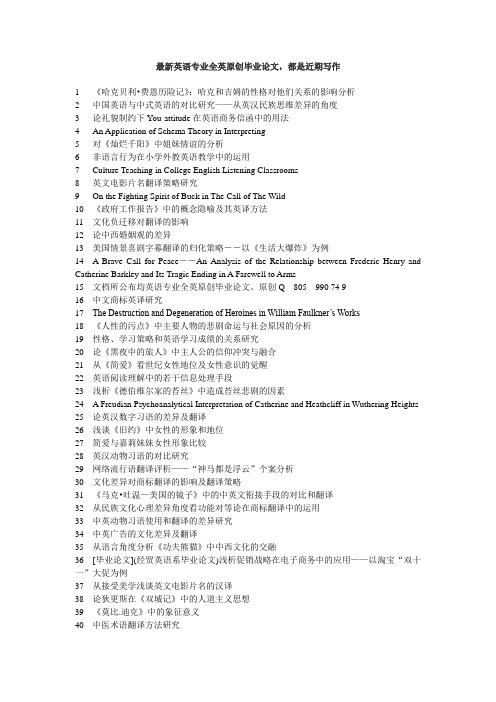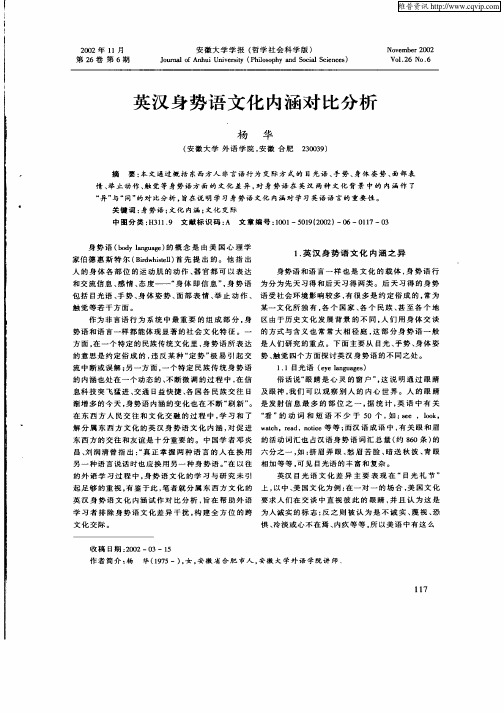汉英身势语的对比研究
优选中西身势语差异BodyLanguage

要点:
一、不同民族在谈话时,双方光接触的艺术。 四、交际中你会微笑吗? 五、手势语 六、中西方文化中的身势语对比。
一、不同民族在谈话时,双方保持多大距离最合 适
二、各国对于身体接触的不同看法
1.握手
在许多国家,握手已成为 一种常 用的表示亲热和友 好的礼节。但各国握手的 习惯不大一样 。
中西握手差别: 就力度来讲,西方人要
重,这与传统观念相关。 西方国家握过手后身体马 上分开;中国人则是先握 手,然后互相靠近,或者 干脆抓住不放。
2.拥抱 在欧美拥抱是跟握手
相提并论的见面礼仪,但 有些国家也不一定拥抱, 如:印度,日本,芬兰等。 在西方国家公众场合的拥 抱是一种礼仪,在中国公 开场合通常不拥抱。
阿拉伯人,俄国人,法 国人以及东欧和地中海沿 岸的一些国家里,两个男 人也热烈拥抱,亲吻双颊 表示欢迎。
3.亲吻 亲吻礼,作为一种重要的社交礼节,是表示亲密、 热情和友好的一种礼节。
(1)同相识的人谈话时,说话的人和聆听的人都应注视对方。 任何一方不看对方,都是不合适的。
(2)如果演说的人埋头看讲稿,照本宣科而不抬头看听众,对听 众"说话",人们就会认为他对听众冷漠,不尊敬别人。
(3)在谈话时,听的人要注视着说话人的眼睛或脸,表示自己在 听,如果对方说的话较长,听的人要不时发出"嗯"的声音,或者 点头表示自己在注意地听着。
欧美人,待别是意大利、法国、荷兰、德国、美 国人多喜欢“亲吻礼”。
• 吻的部位不同,表示的含意也完全不同。 • 吻手表示敬意;
吻颊表示我愿意成为你的朋友; 吻唇表示我喜欢你; 吻额表示关爱; 吻眼表示幻想; 吻掌表示热情;
英汉差异的研究

英汉差异与翻译英语和汉语是世界上使用范围最广、使用人数最多的两门语言, 前者隶属印欧语系( Indo- European Language) , 后者属汉藏语系( Sino-Tibetan Language ) 。
从词源(Etymology) 看, 英汉两种语言相距甚远。
英语和汉语虽然同属曲折变化( Inflection) 较少的分析性语言( Analyticallanguage ) , 但由于各自的历史、地理、政治、经济、文化、风俗、习惯、思维等不同, 英语和汉语在词法、句法、篇章结构诸方面皆存在显豁的差异, 特色鲜明。
恩格斯曾说: 只有将本族语同其他的语言进行比较, 才能真正懂得自己的语言。
对英汉两种语言的差异进行比较, 非常有助于英语学习和翻译实践。
由于英汉两种语言的差异巨大, 本文仅重点从句法层面对英汉语的主要特点和差异进行探讨, 并同时进行翻译实践的尝试。
一、英汉差异比较及翻译1.英语重形合(Hypotaxis) , 汉语重意合(Parataxis)汉语是一种意境( Artistic Concept ion ) 语言, 以神驭形,结构松弛, 多是意思连接的积累式分句或独立单句, 彼此的逻辑关系多以句序之先后加以暗示; 英语遣词造句讲究逻辑性,最忌流散疏放, 借助连接词、关系词、指代词等手段来凸现句子间的逻辑关系, 以形摄神。
语言学家曾用一个生动形象的比喻来说明两者间的差异: 称英语句子为“葡萄型”结构, 汉语为“竹节型”结构。
英汉的形合、意合之别可以说是两者最根本的差别。
形合是明示, 意合是隐含, 在复句内, 英语重形合, 汉语重意合。
译者了解了英汉这种句法差异, 英汉翻译时就会充分发挥各自的优势, 注意各自的特点, 译文才会符合译入语的表达习惯和规范, 不留译痕和翻译腔( Translationese) 。
我们在翻译英语形合句时, 常可把原文的连接词和关联词等省略不译,而译成把各种逻辑关系隐含在句中的汉语意合句。
中西方体态语比较研究(英文版)

AbstractBody language is an important part of nonverbal communication. It is a very usual phenomenon in our daily life. Body language plays an assistant role in communication, especially when communicate with foreigners. But in different countries, body languages have different significances and expressions except some world known ones. This paper,on the basis of some examples,comparing the body languages in the Western countries and China. It aims to illustrate the differences body language in different cultures and put forward the principles of reducing barriers in communication so as to achieve efficient communication and to avoid misunderstanding.Then promote people’s cross-cultural communication competence, reinforce the heart-to-heart understanding and in the end will benefit the communication between Weatern people and Chinese people.Key Words:body language; Western countries and China;comparison; difference; cross-cultural communication摘要体态语是非语言交际的重要组成部分,在我们生活中是很常见的现象。
英汉跨文化非言语交际身势语语用特征及文化差异

英汉跨文化非言语交际身势语语用特征及文化差异1 引言人类交际是语言交际和非语言交际的结合,非语言交际是整个交际中不可缺少的组成部分。
非语言交际指不用词语的交际,有无声和有声之分。
但一般说来,非语言交际多指无声。
我们的面部表情,头部动作,坐立姿势,手势和身体某一部位的移动,身体的接触,对话时的位置和距离,都在有意识无意识的发出某种信息,表达某种意识。
人们就把这种非语言交际方式成为身势语。
身势语主要包括手势,姿态,面部表情,嗓子的音质,交谈者之间的距离,谈话者选择衣着打扮的方法所传递的信息,说话人判断接话时机的方法等。
2 身势语的语用特征作为符号概念的身势是交际和传递信息的符号单位,它用于传递信息,早已未人们所熟悉,并能自如的运用各自群体中所通用的符号势进行交际。
从话语意义的研究角度看,身势语的语用特征主要体现在以下几个方面。
2.1 辅助,替代功能身势语伴随话语,对话语起着补充,强调或者确定的辅助功能,他们相互依附,相互支持以取得预期良好的交际效果。
身势语与话语同时或先后进行,它能使语言表达更生动,更形象,语义信息量更大,更清楚。
由于各种原因,在许多场合人们用身势语来替代话语,并给交际增加了特殊的表现力。
例如:” Pardon me,sir ,will you do mea favor ?Let mepurchase you one of these puddings. It would give mesuch pleasure. ”He jumped back as if he had been stung ,and the blood rushed into his wrinkled face.“请原谅,先生,能赏我个脸吗?让我为您买一只布丁吧,如果您肯收下,我将不胜感激。
”他往后一跳,仿佛被什么东西蛰了一下似的,他那张布满皱纹的脸顿时涨的通红。
2.2 表情功能主要是通过面部表情表露感情或者情绪,当然,身体其他部分也可显露这类情绪。
身势语的比较

A Contrastive Study of Body Language Between Chinese andEnglish-speaking Countries[Abstract] In human communication, people use body language to communicate, as well as verbal language. Body language is also called Kinesics. It belongs to the scope of nonverbal communication. Body language plays an important role in complementing, accenting, symbolizing or substituting utterance meaning. Body language, like verbal language, is also a part of culture. But in different cultures body language means the different things. Different people have different ways of making nonverbal communication. Understanding the different cultural implication of English and Chinese body language can promote people’s cross-cultural communication competence, reinforce the heart-to-heart understanding and in the end will benefit the communication between English and Chinese people. This paper mainly expounds the features and functions of body language in pragmatics, presents the meanings of body language in different cultures from the point of cultures, researches body language’s cultural differences between English and Chinese, especially those in gesture, posture, facial expression_r_r_r, eye contact and physical distance, and discusses the importance of knowing cultural meanings. The research of English and Chinese body language in nonverbal communication is helpful for people todiminish or avoid misunderstandings caused by the cultural differences of body language.[Key Words] body language; English-speaking countries; China; contrast英汉身势语的对比研究[摘要] 人们在进行交流的过程中,除了运用语言这种普遍的方式外,也经常运用身势语。
中西方身势语的文化差异浅论

中西方身势语的文化差异浅论[摘要]在不同文化背景中,身势语的意义并不完全相同。
本文从文化角度对身势语在不同文化背景中的含义作了介绍,阐述了身势语的功能和作用。
通过大量的例证探讨了东西方人在姿态动作、面部表情、目光交流、身体接触和空间距离等方面的文化差异。
[关键词]英语国家;身势语;文化差异一、引言身势语同语言一样,都是文化的一部分。
在不同文化中,身势语的意义并不完全相同。
各民族有不同的非语言交际方式,因此,不断加强对身势语的研究,揭示其文化差异和文化冲突,排除文化干扰,对顺利、成功地进行跨文化交际有着非常重要的现实意义。
非语言交流研究的带头人之一莱伊•伯德克斯戴尔曾就人际交流问题作过如下分析:在两人的对话中,通过语言传达的信息,不过占整体的35%,剩下的65%则通过谈吐风度、动作、姿势、与对方的距离等语言以外的手段传达。
[1]142二、身势语的功能作为伴随语言表达主体意思的一种方式,身势语有其特定的功能和作用,一般来说可以概括为三类:辅助功能、代替功能、和掩饰功能。
下面将从这三个不同的方面进一步研究讨论身势语在英汉两种不同文化环境中存在的差异。
(一)辅助功能身势语伴随话语,对话语起着补充、强调或确定的辅助功能,它们互相支持以取得预期的良好交际效果。
例如,敲桌子提高音量的作用是在进行语言交流时强调语言信息。
用手指指路是进一步明确口头说出的方位。
对恋人用轻缓柔和充满爱意的声音说话,就加强了所说的内容。
在传达某一信息时,我们为了判定这一信息是否被接收、是否被理解,常常注视接受者的反馈。
此时,接收者的点头、眼睛的活动、脸上的表情之类线索,将成为双方调整下一步交流状态的依据。
[2]152-153 身势语与话语同时或先后进行,它能使言语表达更生动、更形象,语义信息量更大、更清楚。
请看下面这段话:With a quick decision he turned to the shop girl and said in a loud voice, “Kindly pack me up this one here. I will take it with me.” He pointed at one of the largest and most expensive of the puddings. 他当机立断,转向女店员,大声说道:“劳驾把这只替我包扎一下,我要带走。
英汉语言对比研究

Prices are stable and the market is flourishing.
7.北方的果树,到秋天也是一种奇景。
Another phenomenon in the North when autumn arrives is the fruit tree.
英语的物称倾向在其造句中十分明显常常出人意料地选择不能施 行动作或无生命事物的词(impersonal, inanimate)。相对而 言,汉语在表达上注意主体意识,一般更习惯人称化的表达,尤 其是主语,能施行或有生命的物体为主语的首选(personal ,
animate)
第四、英语多被动;
1 :Why should all the unpleasant jobs be pushed on to me?
飓风所到之处,庄稼倒伏,树根拔起,房顶掀飞。 2. She is lovely enough to outside the moon
and put the flowers to shame. 她有沉鱼落雁之容,闭月羞花之貌。
第九、重复与替代
英语力戒重复,常用替代,省略和变换表达方法避免,汉 语不怕重复,运用实称,还原和复说。
1. A dialect is known by every linguist in thi2. You don’t grow the grain you eat and you don’t make the clothes you wear.
4. His being neglected by the host added to his uneasiness. 主人对他的冷淡使他更加不舒服。 英语的词汇有形态变化,注重时体(16个时态),汉语基本上没
中西身势语差异Body Language

身势语的功能
• 情感表露 指用面部表情和各种体态动作表达内心的 思想情感。 • 象征动作 指用身体的某一部分象征性地表达一种意 思。 • 伴随动作 指人们说话时同时作出的相关动作,用于说 明、强调说话人表述的意思或反映某种即时的心理状 态。 • 反应动作 指人们在一定场景下作出的适应性动作,这 是对客观情况作出习惯性和机械性的反应。 • 调节动作 指说话双方为了调节彼此之间的交际行为 而作出的体态动作,这是一种非语言的反馈。
在公共场合,交谈者之间相距更远,如:在公共场所演说,教 师在堂上讲课,他们同听众距离很远。 多数英语国家的人不喜 欢人们离得太近,离得太远也有些别扭。离得太近会使人感到不 舒服,除非另有原因,如表示喜爱或鼓励对方与自己亲近等,但 这是另一回事。
二、各国对于身体接触的不同看法
1.握手
在许多国家,握手已成为 一种常 用的表示亲热和友 好的礼节。但各国握手的 习惯不大一样 。 中西握手差别: 就力度来讲,西方人要 重,这与传统观念相关。 西方国家握过手后身体马 上分开;中国人则是先握 手,然后互相靠近,或者 干脆抓住不放。
要点:
一、不同民族在谈话时,双方保 持多大距离最合适。 二、各国对于身体接触的不同看 法。 三、目光接触的艺术。 四、交际中你会微笑吗? 五、手势语 六、中西方文化中的身势语对比。
一、不同民族在谈话时,双方保持多大距离最合 适
不同的民族在谈话时,对双方保持多大距离才合适有不同的看法。 在进行社交或公务谈话时,有四种距离表示四种不同的情况: • (1)亲密距离(0~45cm),适合于夫妻关系及情侣之间; • (2)私人距离(45~120cm),限于朋友、熟人或亲戚间的交往; • (3)礼仪距离(120~360cm),用于处理非个人性事务的场合之 中; • (4)公共距离(360~750cm),适用于非正式的聚会。
中西文化差异背景下的身势语初探

差异 。
2. 动作语言
由于不同民族的文化已经是根深蒂固 ,不容易接受与自己的习惯相反
在交际过程中 ,人体的各个部分都会有一定的动作 ,这些动作表达不 的信号 ,所以我们不能忽视文化约束力对身势语的影响以及文化和环境差
同的意思 ,我们把这些叫做动作语言 。在动作语言中 ,手的动作最为丰富 , 异所赋予身势语的不同含义 。最为熟悉的动作就是将食指和中指构成一
表情语言中 ,用眼睛交流是人类普通的交际行为 ,由于民族和文化的
语言等方面来探究身势语 。
差异 ,东西方的目光表现都有不同的含义 。东方人交谈的时候 ,习惯于眼
一 、身势语的分类
睛只看到对方的颈部 ,以表示对发言者的尊重 ,而美国人交谈往往将目光
1. 表情语言
注视着对方的眼睛以表示对发言者的尊重 。
于膝盖上或在胸前做较少的手势 ,而欧美领导人一般是翘着二郎腿 ,上身 定民族的文化素质提升到新的高度 。
半侧 ,手臂的动作幅度较大 。这两种姿态给人完全不同的印象 ,前者端庄
身势语涉及文化 、艺术 、文学 、科学 、民俗 、心理学 、社会学 、宗教 、历史
大方 ,后者潇洒自如 ,但都有一定的男士风度 。
通的情况下人们就可以用这种非语言的手段来交际 。
同 ,打叉则表示否认或不同意 ,而英语语言区国家则以打叉表示肯定或赞
当然 ,在不同文化背景下 ,同样的身势语所传达的信息是多种多样 成 。在国际交流中 ,若要进行非语言交际 ,一定要注意不同文化下身势语
的 ,一方面 ,时代 的 发 展 逐 步 影 响 着 身 势 语 的 表 达 , 譬 如 握 手 源 于 西 所表达的不同含义 ,否则就会出现令人尴尬的场面 。
它是最便利的交际工具 。见面要握手 ,说话有动作 ,再见要挥手 ,手的动作 个 V 字 ,就是从 英 文 的 V ICTORY 得 来 的 , 现 在 在 中 国 也 用 的 很 多 。而
汉英身势语的对比研究

最新英语专业全英原创毕业论文,都是近期写作1 《哈克贝利•费恩历险记》:哈克和吉姆的性格对他们关系的影响分析2 中国英语与中式英语的对比研究——从英汉民族思维差异的角度3 论礼貌制约下You-attitude在英语商务信函中的用法4 An Application of Schema Theory in Interpreting5 对《灿烂千阳》中姐妹情谊的分析6 非语言行为在小学外教英语教学中的运用7 Culture Teaching in College English Listening Classrooms8 英文电影片名翻译策略研究9 On the Fighting Spirit of Buck in The Call of The Wild10 《政府工作报告》中的概念隐喻及其英译方法11 文化负迁移对翻译的影响12 论中西婚姻观的差异13 美国情景喜剧字幕翻译的归化策略--以《生活大爆炸》为例14 A Brave Call for Peace--An Analysis of the Relationship between Frederic Henry and Catherine Barkley and Its Tragic Ending in A Farewell to Arms15 文档所公布均英语专业全英原创毕业论文。
原创Q 805 990 74 916 中文商标英译研究17 The Destruction and Degeneration of Heroines in William Faulkner’s Works18 《人性的污点》中主要人物的悲剧命运与社会原因的分析19 性格、学习策略和英语学习成绩的关系研究20 论《黑夜中的旅人》中主人公的信仰冲突与融合21 从《简爱》看世纪女性地位及女性意识的觉醒22 英语阅读理解中的若干信息处理手段23 浅析《德伯维尔家的苔丝》中造成苔丝悲剧的因素24 A Freudian Psychoanalytical Interpretation of Catherine and Heathcliff in Wuthering Heights25 论英汉数字习语的差异及翻译26 浅谈《旧约》中女性的形象和地位27 简爱与嘉莉妹妹女性形象比较28 英汉动物习语的对比研究29 网络流行语翻译评析——“神马都是浮云”个案分析30 文化差异对商标翻译的影响及翻译策略31 《马克•吐温—美国的镜子》中的中英文衔接手段的对比和翻译32 从民族文化心理差异角度看功能对等论在商标翻译中的运用33 中英动物习语使用和翻译的差异研究34 中英广告的文化差异及翻译35 从语言角度分析《功夫熊猫》中中西文化的交融36 [毕业论文](经贸英语系毕业论文)浅析促销战略在电子商务中的应用——以淘宝“双十一”大促为例37 从接受美学浅谈英文电影片名的汉译38 论狄更斯在《双城记》中的人道主义思想39 《莫比.迪克》中的象征意义40 中医术语翻译方法研究41 语言行为性别差异研究42 从凯特肖邦的“觉醒”中映射出的女性自由43 从冲突到和解—解析《接骨师之女》中的母女关系44 游戏教学法在初中英语课堂教学中的应用45 Cooperative Learning in English Interpretation Class46 澳大利亚英语词汇和澳大利亚文化(开题报告+论)47 汉英语序对比浅析48 Influences of Encouraging Words on Students In High School Classes49 A Study on Differences of Family Education between China and America--A Case Study of The Joy Luck Club50 Scarlett的人物形象分析51 目的论视角下的化妆品翻译52 A Preliminary Survey of Translating San in Chinese Idioms53 An Analysis on Shear's Personality in The Bridge on the River Kwai54 文化对在校英语学习的重要性55 A Comparison of the English Color Terms56 A Cultural Approach to the Translation of Movie Titles57 从跨文化交际视角谈品牌翻译策略58 浅析《白牙》中爱的力量59 《请买票》的生态女性主义解读60 The Comparison of Marriage Traditions between China and America61 伊丽莎白.贝内特与简.爱的婚姻观之比较62 论英汉基本颜色词的文化内涵差异63 《我的安东妮娅》中的文化冲突研究64 浅谈英语中歧义65 An Analysis of Key Elements of Cross-cultural Business Negotiation66 英语歌曲名称汉译研究67 《远离尘嚣》中女主角的情感变迁研究68 杰克•伦敦《野性的呼唤》的生态解读69 对跨文化交际中肢体语言的研究70 A Comparative Study on Gratitude Expressing Approaches of Chinese and Western Relatives71 Psychological Analysis of Stuttering in The King’s Speech72 《基督山伯爵》中的复仇,复活以及宽恕73 全身反应法在少儿英语教学中的应用——以杭州英之辅EF语言培训为例74 论中西文化中家庭观念的差异75 On Advertising Translation from the Perspective of Skopostheorie76 浅谈《竞选州长》中的幽默与讽刺77 A Script-based Study of the Female Theme in Scent of a Woman78 卡门-波西米亚之花79 打破沉默——接骨师之女中“沉默”主题的解读80 试析《献给艾米莉的玫瑰》中女主人公艾米莉的形象81 非言语交际对演讲的影响82 经济学视野下的《鲁滨逊漂流记》83 任务型英语教学的理论与实践探讨84 《远离尘嚣》人物分析及悲剧写法85 从女性主义的角度研究萧伯纳《华伦夫人的职业》中的女性形象86 东西方隐逸文化对比——试比较梭罗与陶渊明的作品87 论爱伦•坡小说《莫格街谋杀案》中悬疑的设置88 论《兔子归来》中黑人民权意识的觉醒89 《神探夏洛克》文化现象研究90 图式在英语阅读中的作用91 英文电影片名翻译中的归化与异化策略92 大学生英语学习归因倾向的调查研究93 《紫色》的妇女主义解读94 埃德娜:一个孤独的女战士——解读凯特•肖邦的《觉醒》95 A Research on Frances Burnett’s “Fauntleroy” Writing Style96 解析网络语言的变异97 对罗伯特•弗罗斯特自然诗的尝试性研究98 论《宠儿》中的象征意象99 关注耐心教育——浅谈《差不多是大人的人》中黑孩子的叛逆心理100 《名利场》的女性主义解读101 禅宗思想在艾米莉迪金森诗歌中的体现102 中西饮食文化差异探析103 论委婉语与国际商务谈判104 伍尔芙的人生经历对其小说创作的影响105 旅游翻译中的文化差异和处理策略106 汽车广告英语的语言特点及其翻译107 Negative Transfer and the Errors Committed by Chinese English Learners108 Sino-US Cultural Differences——Through Comparison Between APPLE and OPPO 109 时政漫画看美国社会110 浅析《儿子与情人》中的恋母情结111 文化差异对英语学习的影响112 《名利场》的女性主义解读113 外贸函电写作中存在的误区及其对策114 盖茨比的悲剧成因分析115 从语用学角度分析《老友记》中的幽默116 对公共演讲课堂中大学生课堂表现的心理分析117 比较约翰·邓恩与艾米丽·迪金森诗歌中奇思妙喻的艺术效果118 会计文本语言特色分析——以《国际收支手册》为例119 A Tentative Study of the Origin of American Place Naming120 Wessex Women: Female Characters in Thomas Hardy's Novels121 聊天室中网络英语缩略词浅析122 Improving the College Students’Writing Skill through Cohesive Devices123 如果不复仇——论呼啸山庄中的爱与恨124 An Analysis of the Fatalism and Pessimistic View in Tess of the D’Urbervilles125 从认知语言学的视角下浅析隐喻和换喻的异同126 汉语中的英语外来语127 从文化角度探析中英基本颜色词的比较和翻译128 解析马克吐温《竞选州长》中的幽默讽刺艺术129 诠释《儿子与情人》中儿子、母亲、情人之间的关系130 抽象名词词义内涵及其翻译策略131 中西方文化中颜色词的隐喻比较研究132 合作原则视角下对《老友记》中台词的幽默研究133 中国奢侈品的营销之道134 浅析中美幽默之差异135 从语用学的角度谈美剧中的言语幽默——以《老爸老妈浪漫史》为例136 梭罗《瓦尔登湖》中的“简单”原则137 A Comparison of the English Color Terms138 重新诠释玛格丽特的人生悲剧根源139 从电视剧《绝望主妇》看委婉语的交际功能140 Two Trapped Roses—A Comparative Study on Emily and Miss Havisham141 A Brief Discussion on the Translation of Brand Names142 论《追风筝的人》中父子关系的心理剖析143 从数字的联想意义研究中西文化的差异144 论《了不起的盖茨比》中的象征及其作用145 中英爱情隐喻的对比研究146 简爱与林黛玉的形象比较分析147 从电影《美丽人生》看完美男人形象148 从动态对等角度分析中国旅游景点名称英译——以中国庐山网为例149 《喜福会》体现的中美家庭观念冲突解析150 托马斯•哈代《无名的裘德》中的书信研究151 傅东华译《飘》归化现象浅析152 浅析英语委婉语的应用领域153 论海勒《约塞连幸免于难》的黑色幽默的荒诞与反讽154 The Interpretation of A Rose for Emily from the Perspective of Feminism155 西方骑士精神与中国侠义精神的比较研究—以《亚瑟王之死》和《水浒传》为例156 《哈利波特》中西弗勒斯•斯内普的人物分析157 旅游资料翻译中文化因素的处理158 从《麦琪的礼物》看欧亨利留给世人的礼物159 凯特•肖邦《觉醒》中女主人公女性意识的觉醒160 论莎士比亚戏剧中的女扮男装现象161 从尤金•奈达的功能对等理论角度论网络流行语的可译与不可译162 Pragmatic Differences of Politeness in Intercultural Communication Between English and Chinese163 论旅游广告的显影性164 The Death Image of Emily Dickinson’s Poetry165 《园会》中男性人物性格作用分析166 论《麦田里的守望者》中的象征体系及霍尔顿的精神世界167 从追求走向幻灭与死亡——谈马丁•伊登的美国梦168 On Characteristic Features of the Main Characters in The Moon and Sixpence169 中西方文化背景对理解隐喻的影响170 A Study on Humanity——Based on the Analysis of David Copperfield171 论纳撒尼尔霍桑《牧师的黑面纱》中的象征172 英语写作中的母语迁移作用及教学启示173 A Withering Rose:An Analysis of Tess’s Tragedy174 英语商标的汉译原则及策略175 英语抽象名词和物质名词的数概念分析176 A Comparison of the English Color Terms177 《奥罗拉•李》中的女性形象解读178 《可爱的骨头》的电影改编分析179 论《小妇人》中的家庭教育问题180 Cause of Tragedy in Desire Under the Elms181 福斯特《霍华德庄园》中的三个世界182 浅析委婉语的构造方式及功能183 中英文化中寒暄语的比较184 意象图式研究185 语用模糊及语用功能186 适者生存—对《飘》中生存意识的探究187 《飞屋环游记》的人物设置特色分析188 从文体风格谈培根散文《论美》的翻译189 美国文学中的美国梦研究190 从文化差异的角度对英语习语翻译的研究191 从《简爱》和《藻海无边》看罗切斯特对女性和婚姻的态度变化192 《最蓝的眼睛》中佩科拉的悲剧193 文化差异视角下的英语称谓语的翻译策略194 从《纯真年代》中的女性角色看伊迪斯•华顿的女性意识195 加工层次理论指导下的商务英语词汇学习196 The Tragic Destiny of Brett Ashley in The Sun Also Rises197 《瓦尔登湖》中寂寞观的超验主义分析198 Analyzing the Development of English Color Term and Its Chinese Translation199 On C-E Translation of Neologisms from the Perspective of Nida’s Functional Equivalence Theory200 浅谈商务英语合同的翻译。
浅谈英汉身势语的文化差异

浅谈英汉 身势语的文化差异
杨 春 会
( 尔滨体育学院公共课教学部, 哈 黑龙江 哈 尔滨 1oO ) 5 00
摘要 : 身势语是人类社会 文化 交流和发展的产物 , 是传递信息的一种非语 言手段 。它同语言一样是民族文化 的一部 分, 在人 们的交际中起着独特 的不可忽视 的作用。由于文化风俗 的差异, 英汉文化都有属 于自己的身势语 , 并存在 差异性 , 了解这些 文化 差异有助 于跨文化交际。本文从 面部表情着眼介绍 了 汉身势语 的差异。 英 关键词 : 英汉身势语 ; 文化差异 ; 面部表情
2 0 年第 0 期 09 5 第2 s卷 ( 2 1期 ) 总 2
吉林省教育学院学报
J R L OF E C 0U NA DU NA S n’ E 0F JU P L DiT Ur I R0、 CE , l
Nn 5.o 9 O 2 o V0 5 L2
的 。中 国人 用 拇 指表 示 “ ” 用 小 手 指 表 示 “ ” 好 , 差 ,
不清中国人笑的含义 了, 要理解那么多的含义并 学 会识别 确实 有一定 难 度 。 英 汉不 同的文化差异 导致 了英汉身势语 的差 异, 这种差异往往会导致跨文化交际 中相互间的信 息传递不畅 , 引起文化 冲突。要使跨文化交际获 得 成功 , 就必须注重英汉身势语 的文化差异。 三 、 少 英 汉 身 势 语 表 达 中 文 化 冲 突 的 几 个 减
中图分 类号 : 3 3 1 H 1. 文献标识码 : A 文章编号 :6 1 18 (09 0—0 0—0 17— 5 0 2o )5 0r 2 7
d8 a rl) py 它 每 作为非语言交际的一种重要手段 , 身势语是表达 了显露 规则 ( i l ue 的概 念 , 表 明“ 种 文 化 这些规则指导个人显露社 个人内心世界的无声而真实的语言, 是一个民族文 都发展了一系列的规则 , 它表达个人在一定 的条件下所 体 化的一部分。由于不同民族的文化已经根深蒂固, 不 会所认可的行为 , 验的情绪。不 同的文化有不 同的显 露规则 , ” 以笑 为 容易接受与 自己习惯相反的信号 , 以我们不能忽视 所 文化约束力对身势语 的影响以及文化环境差异所赋 例, 中国人 的笑在某些场合会 引起外 国人 的反感 。 予身势语的不同含义。英汉文化存在着极大的差异, 个美 国人失手摔了一个盘子 , 他本来就感 到很窘 这种差异直接制约着我们对身势语信息的正确获得。 迫, 而在场的中国人发出的笑声使他更加觉得不是 又气又恼。其实这种笑并非嘲笑 当事人 , 也不 如果交际双方不注意这种文化差异, 就会使交际发生 滋味 , 只是表示“ 当一 回事 ” “ 别 、 没关系” 的 障碍 , 造成相互间的信息传递的不畅。对英汉身势语 是幸灾乐祸 , 进行对 比研究具有极其重要的现实意义 , 它不仅有助 意思 。 于英语语言学习者更好地掌握英语语言文化, 而且还 英美人对 中国人的微笑也感到不可思议 , 称 并 会避免英汉两种语言使用者在实际交际中产生一些 之为“ 比蒙娜丽莎还 蒙娜丽莎 ” 不 可捉摸 的微 的“ 笑” 。一个 比较典型 的例子是 : 一位美 国留学生 回 不应有的误会 , 从而大大提高交际效果。 校后很不高兴地向中国老师诉说她在那里的不愉快 英 汉 文化 中身势 语的差 异 中西文化底蕴各不相 同, 这直接体现在语言当 遭遇 , 老师一直微笑地听着 , 学生很不高兴 , 质问老 老师会用很 明显 的感 中, 这一点在身势语方面体现得尤为明显 。而面部 师为什么发笑 。因为在美国, 情共鸣的表情做出反应 ; 中国的老师看起来似乎 而 表 情是 说话 时最 明显有 效 的辅 助 方式 , 此本 文 以 因 身势语 当中的面部表情为例来解析一下英汉身势语 是在幸灾乐祸 。再如 中国人 习惯 以微笑来 表示友 愉快 、 满意或者安慰。唐玄宗诏令快骑从岭南千 的文化差异 。面部表情是身势语 中最能表现人情绪 好、 里运送荔枝以取悦于杨贵妃的故事在诗人笔下成为 的一种手段 。由于生理和心理 的原因 , 人们内心 的 各 种情 绪不 可避 免地 会从 面部 反映 出来 。面部 表情 骑红尘妃子笑 , 无人知是荔枝来” 的名句。杨贵 在人际交流 中 占有 相当重要 的地位 。人 的基本感 妃的满心喜悦在一个“ ” 中得 以生动体现 , 笑 字 但这 情, 如喜、 哀、 、 、 、 怒、 欲 爱 恶 惧等都可以通过面部表 种含蓄的微笑在英美人眼里变得 “ 不可捉摸 ” 。中 情 反映 出来 。 国人的笑 的含义很多, 既可以表示赞赏 , 又可以表示 人类面部表情 由生物遗传 , 由于文化传统不 不 同意 、 但 不屑一谈、 接受对方的好意 、 听不 清对方说 同, 人们对某一事物 的面部表情反应 也会有差异。 了什么 , 以及回避其他不便或不愿明确表态 的含义 , 也难怪 外 国人 会弄 不懂 了。 弗里森 和汤姆金斯在大量实验和研究的基础上提出
中西身势语的文化差异及其交际功能研究

中西身势语的文化差异及其交际功能研究作者:姜玉来源:《亚太教育》2016年第26期摘要:身势语是运用范围最为广泛、人类社会最为容易接受、交流障碍最轻的文化交流途径,世界范围内的文化差异导致了全球范围内、尤其是中西方文化之间身势语所代表的文化内容都会呈现出极大的差异性,这就需要我们作为语言的研究者和使用者进行认真学习,全面掌握身势语的使用技巧。
关键词:身势语;中西文化差异;交际功能从古至今,人类社会中的文化交流、人际交往、思想传递、信息互通等交流行为,除了依赖语言文字之外,还可以依赖非语言行为来实现,这其中,身势语就是运用范围最为广泛、人类社会最为容易接受、交流障碍最轻的文化交流途径,故此,我们每一位语言学习者就应重视身势语的学习。
从文化交流与文化传播的角度来看,文明与文化虽然具备世界范畴,但不同的地区、不同的国家、不同的民族都普遍存在着一定的文化差异,这些差异就导致了全球范围内、尤其是中西方文化之间身势语所代表的文化内容都会呈现出极大的差异性,身势语在从事文化交际时就需要我们每一位语言学习者进行认真思考、仔细研究,力争通过最为恰当的身势语来实现中西文化之间的交流往来。
一、身势语的文化交流功能顾名思义,身势语主要包括目光语、手势语、空间距离、面部表情和身体接触等集中表现形式,简言之,身势语有以下一些文化交流功能:1.信息强调功能。
人与人之间在进行交流对话说,往往感觉到口头表达表达不出来所想要的效果,就借用一些手势、动作、面部表情等途径,来强调自己想要表达的内容,希望引起对方的注意,这就是身势语的信息强调功能,一些简单的动作、细节都可以把对话的一方的重点内容层次分明、有轻有重的传达到另一方。
有时一些动作,看起来并不显眼,但用在人际交流时,却会能实现良好的效果,这就对口头表达、文字交流起到了有益的补充,对一些重点内容还达到的强调的效果,更为重要的是,这些动作或细节,不会引起对方的反感,双方还都认同这种方式。
英汉身势语文化内涵对比分析

息 科 技 突 飞 猛 进 、 通 1 快 捷 、 国 各 民 族 交 往 1 及 眼 神 , 们 可 以 观 察 别 人 的 内 心 世 界 。 人 的 眼 睛 交 3益 各 3 我
渐 增 多 的 今 天 , 势 语 内涵 的 变 化 也 在 不 断 “ 新 ” 是发 射信 息 最 多 的 部 位 之 一 , 统 计 , 语 中有 关 身 刷 。 据 英
手 身 方 面 , 一 个 特 定 的 民 族 传 统 文 化 里 , 势 语 所 表 达 是 人 们 研 究 的 重 点 。 下 面 主 要 从 目 光 、 势 、 体 姿 在 身
的 意 思 是 约 定 俗 成 的 , 反 某 种 “ 势 ” 易 引 起 交 势 、 觉 四 个 方 面 探 讨 英 汉 身 势 语 的 不 同 之 处 。 违 定 极 触
维普资讯
20 0 2年 1 1月
安徽 大 学学 报 ( 学 社会 科 学版 ) 哲
J u a fAn u iesy ( hlsp y a d S ca ce c s o r lo h i v ri P i o h n o ilS in e ) n Un t o
情 、 止 动作 、 觉等 身势语 方 面 的文 化 差异 , 身 势语 在 英汉 两种 文 化 背景 中 的 内 涵作 了 举 触 对 “ ” “ 的 对 比分析 , 异 与 同” 旨在 说 明 学 习 身 势 语 文 化 内 涵 对 学 习 英 语 语 言 的 重 要 性 。 关 键 词 : 势 语 ; 化 内涵 ; 化 交 际 身 文 文
1英 汉 身 势 语 文化 内涵 之 异 .
身 势 语 和语 言 一 样 也 是 文 化 的 载 体 , 势 语 行 身
人 的 身 体 各 部 位 的 运 动 肌 的 动 作 、 官 都 可 以 表 达 器
英汉体态语异同之浅析

英汉体态语异同之浅析摘要:体态语是非语言交际中的一个重要组成部分,是当今跨文化交际必不可少的重要手段。
英汉两种语言中都有大量的描述体态动作的词语,本文从非语言交流手段的使用实例上对它们进行了对比分析,探讨它们的异同点及其产生的根源。
关键词:英汉;体态语;文化一、引言萨莫瓦曾说:“在面对面的交际中,信息的社交内容只有35%左右是语言行为,其它都是通过非语言行为传递的。
”体态语(body language)就是非语言交际的一种形式,它是通过人们交际时的姿态、动作、表情及相隔的距离等来传达信息的。
与有声语言相比,体态语更具有人类共通性的一面,但往往又带有十分明显的民族、文化的特征,尤其是当许多形体动作渐渐成了特定的程式化的规则之后,更能反映出它们所处的社会文化背景。
各语言中都存在大量的反映人们身体动作、面部表情、服饰容貌等的表达法,这些描绘体态语的表达法由于其生动形象而往往能在语言中固定下来,渐渐地转化为词语。
英汉两种语言中都有相当数量的描述体态动作的词语,本文拟对它们进行对比分析,探讨它们的异同点及其产生异同的根源。
二、从非语言交流手段的使用上分析异同1. 非语言交流手段的普遍性所谓非语言交流手段的普遍性,即其为世界上绝大多数民族所接受和理解的国际性。
人类自古以来就有的面部表情,作为表达情感的交流手段,基本上是相同的。
描述体态动作的词语丰富多彩、生动活泼,在英汉两种语言中都可以找到反映各类体态动作的词语。
如反映面部表情的,在英语中有pull a long face(形容忧郁的面孔),grin from ear to ear(咧嘴大笑);汉语中有“愁眉苦脸,和颜悦色,嘻皮笑脸”等。
2. 非语言交流手段的非普遍性所谓非语言交流手段的非普遍性,即为基于民族之间生活习惯、宗教文化、生活环境的不同,而在语言行为上体现的差异。
从来源上看,描述体态动作的词语主要涉及宗教、文学、风俗习惯等方面。
英语文化受基督教影响很深,词语中最典型的手势便是cross one’s heart(在胸口划十字发誓),以及cross one’s fingers or keep one’s fingers crossed(将食指与中指交叉以祈求好运),两者均来源于基督教传统的划十字方式,而在中国,佛教的影响则远远超过了其他宗教,于是汉语中有“菩萨低眉,金刚怒目,拈花一笑,五体投地”等词语,同样表示祈求好运或发誓,汉语中的词语有“双手合十,指天发誓或对天发誓”。
英汉语言对比研究

01
词性变化
英语有丰富的词性变化,而汉语 则没有,这导致英汉互译时需要 灵活处理。
句子结构
02
03
时态和语态
英语句子结构严谨,层次分明, 而汉语则更加灵活,强调意合而 非形合。
英语时态和语态表达丰富,而汉 语则通过语境和时间副词来表达 时态和语态。
04 句子结构对比
英语句子结构特点
主语+谓语+宾语
汉语词汇特点
汉语词汇相对稳定
与英语相比,汉语词汇的变化相 对较小,一些古老的词汇在现代 汉语中仍广泛使用。
语义内涵丰富
汉语词汇往往蕴含着丰富的文化 内涵和意象,如成语、谚语等, 这反映了汉语表达的深刻性和形 象性。
新词创造有限
相对于英语,汉语新词的创造速 度较慢,一些新出现的词汇往往 是通过已有的词汇组合而成。
英汉文化背景差异对比
个人主义与集体主义
英语文化强调个体和独立,而汉语文化强调整体和关联。这种差异在语言中表现为英语更注重第一人称和个体视角, 而汉语更注重集体和整体视角。
竞争与和谐
英语文化强调竞争和个人实现,而汉语文化强调和谐与人际关系。这种差异在语言中表现为英语更直接和竞争性的表 达方式,而汉语更注重委婉和协商性的表达方式。
04
英语常用复杂句型,如复合句和从句,以表达复杂的概念和逻辑关系。
汉语语言特点
01 汉语是一种意合语言,主要通过词汇和语 境来表达意义,较少依赖形式变化。
02 汉语强调主题和述题的完整性,句子结构 较为灵活。
03
汉语中常用主动语态,强调动作的施事者。
04
汉语常用简单句型,如短句和流水句,以 表达简洁明了的语义。
英汉语言对比研究
目录
中西身势语差异Body Language

在公共场合,交谈者之间相距更远,如:在公共场所演说,教 师在堂上讲课,他们同听众距离很远。 多数英语国家的人不喜 欢人们离得太近,离得太远也有些别扭。离得太近会使人感到不 舒服,除非另有原因,如表示喜爱或鼓励对方与自己亲近等,但 这是另一回事。
二、各国对于身体接触的不同看法
1.握手
在许多国家,握手已成为 一种常 用的表示亲热和友 好的礼节。但各国握手的 习惯不大一样 。 中西握手差别: 就力度来讲,西方人要 重,这与传统观念相关。 西方国家握过手后身体马 上分开;中国人则是先握 手,然后互相靠近,或者 干脆抓住不放。
微笑对象的不同:
美国:他们用同样的态度对待每个人,他们习惯 微笑着彼此打招呼。在公众场合,对陌生人也 毫不吝啬的给予微笑。所以在其他文化的人看 来他们的微笑显得不真诚,硬梆梆。 中国:在中国微笑是一种礼仪。对于熟人,见面 时会经常朝他们笑,对于陌生人却往往不愿意 或者觉得没必要这么做。通常只有在有求于人 的时候才向陌生人笑。如,问路的时候。
• 我吃饱了(饭后):西方人把一只手放在 自己的喉头,手心向下,手指伸开。中国 人用一只手或两只手轻轻拍拍自己的肚子
妈妈,过 来。
come here
⑶、汉语中有而英语中无。
• 拱手礼:拱手礼也叫作揖礼。这个礼既能 表达晨报对您的感谢和尊敬,也是咱们中 华传统的见面礼仪,有着浓浓的中国特色 和人情味儿。 • 双手递物:表示尊敬 • 用食指点点或指指自己的鼻子:表示“是 我”,“是我干的”(西方则认为这个动 作很可笑)
伸出小指:在日本表示女人、女孩子、恋人;在韩国表示妻子、妾、 女朋友;在菲律宾表示小个子、年轻或表示对方是小人物;在泰 国、沙特阿拉伯表示朋友;在缅甸、印度表示要去厕所;在英国 表示懦弱的男人;在美国、韩国、尼日利亚还可以表示打赌。
英汉生理现象委婉语对比研究

英汉生理现象委婉语对比研究在现代社会中,委婉语的运用是世界各民族语言中的普遍现象。
英汉两种语言中都有大量的委婉语,文章就英汉语中的生理现象委婉语进行了对比分析,以寻求其共性和个性,加深对英汉委婉语的认识。
标签:委婉语;英汉对比;生理现象一、引言运用委婉语是世界各个地区的普遍现象。
在很多情况下,人们忌讳说令人不悦、感觉不文雅的生理现象,于是选择含蓄、模糊、委婉的方式来表达生理现象。
英汉生理现象的委婉语具有很多相似之处,但因为英语和汉语属于两种不同的语言,在历史、文化、价值等方面存在着较大差异,因而英汉生理现象的委婉语存在着很大的不同。
本文就生理现象这一方面对英汉委婉语进行了对比研究。
二、委婉语的含义英语中的euphemism即汉语中的委婉语,euphemism源于希腊语euphemismos,前缀eu-意为well、pleasant、good;词干-pheme-意为speech。
因此,euphemism是指“说好听的话”或“讨人喜欢的话”。
人们因为有些事物不能、不便、不愿直接描述或表达,直接说明或提及这些事物会让言者、听者、被提及者有消极的心理反应,因而用委婉语去替代直截了当的、可能触怒人的词语来避免情感伤害或引起不快。
委婉语是从语言禁忌开始的,当人们不愿意说出禁忌的事但需指明此事时,就不得不用其他词语来代替禁忌词语,于是创造了委婉语。
语言禁忌的出现源于人们对语言的崇拜,人们认为语言拥有超自然的神力,语言等同于客观事物。
比如,开店做生意的人每天关门说打烊而不是关门,因为关门有“破产倒闭”之意,如果说关门,那么就可能会不幸言中。
三、英汉生理现象委婉语的对比研究语言禁忌受制于民族文化、价值观念等人文因素的影响,具有民族个性,因而委婉语也具有民族个性。
英语和汉语属于两种不同语言,而民族文化、价值观念等人文因素都存在差异,因此决定了英汉委婉语差异十分明显。
我们可以从英汉两种语言中的几种主要的生理现象的委婉语窥见一斑。
中英身势语的比较英文版

A Comparison of Body Language between China and English-speaking CountriesWith the development of inter-cultural communication, the role of non-verbal communication becomes more and more obvious, which means that the position of body language is also becoming increasingly important. Therefore, if we want to have a successful inter-cultural communication it is very necessary for us to understand the similarities and differences of body language in different countries. There are many examples which can show the similarities and differences between China and English-speaking countries. And the comparison of body language between China and English-speaking countries is a very complicated question for us to understand them drastically. And it is a very hard task for us to learn every body language of every nation and countries. So this article mainly takes some typical ones to explain the similarities and differences of body language between China and English-speaking countries.3.1 The GesturesIn stead of verbal communication, people can also communicate and express our thoughts by the movements and patters of hands and fingers. And that is called gesture communication. Gesture communication which is the core of non-verbal communication plays a very important role in the whole communication. But gesture has different meanings in different countries and different cultural backgrounds also give the same gesture different functions in communication. For example, Chinese people show the meaning of good by thumbs up and show the meaning of bad or poor by extending the pinkie. However, the situation in America is not the same. If Americans extend their thumbs up that means hitchhike. There are also some other typical examples can show the importance of gesture in inter-cultural communication. And following are the examples.Firstly, in China, people move their fingers around the temples it means they are thinking. But in America, if people move their fingers around their temples it means that they are crazy. Secondly, when Chinese people see the foreign gusts use their palms across the neck after the dinner they feel very amazed because they can not understand why the foreigners show the action of suicide after the dinner. But in fact, the Americans just want to show that they are stuff.Thirdly, the posture of salutation is also different between China and English-speaking countries. If people want to ask someone to come over they will move their index finger upward and inside in English-speaking countries, while Chinese people will move their hands down and towards themselves. The gesture of number is another typical example which shows the differences of body language between China and English-speaking countries. Take the number 10 for example, in English-speaking countries, people will show the meaning of ten by opening their two fists, while Chinese people express the meaning of ten by making a fist by one of their hand. There are also a number of unique gestures in China and English-speaking countries, such as o-type gesture, which means zero or no in France and which refers to a man with homosexual tendencies in some Mediterranean countries. O-type gesture means both three and zero in China. The sign of victory between China and English-speaking countries can also show the cultural influence of the body language among different nations. In English-speaking countries, the V-type gesture express the meaning of victory and this action started from the World War II when Churchill took this gesture to show meaning of victory. But in China, the way to show victory is that people hold the arms and wave their hands in the air. For example, when Chinese athletes win the games in the sport meeting the always do this action to show their mood. The main reason forthose situations above is that the habits of different nations are not the same. It is well known to us, the habits can be represented through the behavior. And the habit can also incarnate the historical backgrounds of culture in different countries. So the differences and similarities of body language are still inseparable from the culture. In personal contacts everyone has his or her gesture. And because of the differences of culture, the gestures bring us many conveniences. But at the same time it also causes many troubles, especially in inter-cultural communication. If we do not know the meaning and ambiguity of gestures in the communication, we will not be success in the inter-cultural communication in both our daily life and in the business.3.2 The Facial ExpressionThe importance of facial expression in non-verbal communication is recognized for most of us. But the various cultural connotations of facial expression are hard to estimate. Compared with any party of body movement, the facial movement is more unpredictable and vague. Most of the facial movement are innate rather than acquired result of cultural. Rules about facial expression are too numerous and complex. It is difficult for us to know all the details, but we can try to understand the basic ones. Smile is a very important and common facial expression. In the culture of both China and English-speaking countries, a slight smile means happiness. However, in daily behavior, because of the humble attitude of the people in China and conceited attitude in English-speaking countries, there are really some differences of facial expression which can be not ignored among those countries. For example, when people are praised sincerely by others Chinese people always give a negative response both in language and action with the facial expression of denial, unacceptable, unbelievable and so on, while the people in English-speaking countries will accept the praise with smile and say thank you. Chinese people always think that this attitude of the English-speaking countries is too proud and arrogant. Conversely, English-speaking countries' people believe that Chinese people are too modest. Just from this, we can get the differences of the way of thinking between Chinese people and English-speaking countries' people.Eye contact is another typical example of facial expression. Eye language means that people use their eyes to convey information and express our thoughts and it is also a very important means of communication. As the common saying goes eyes are the windows of the soul, and which shows that through the eyes we can understand others' inner world. But due to the similarities and differences among countries, eye language also does not express the same meanings in different countries. For example, English-speaking countries' people always disgust that Chinese people often look back others in a very short time in the communication and the believe that this action is the symbol of looking down upon them. Though people in both China and English-speaking countries think that it is not a good habit when you communicate with others without the eye contact, the concrete reason of this attitude is not the same between Chinese and English-speaking countries' people. The people of English-speaking countries think that the lack of eye contact during the conversation is a symbol of lacking honesty and interest, while Chinese people think that is a symbol of lacking respect and obedience. In America, there is such a saying, do not believe those people who can not look at you directly. British people also think that you should look at each other directly to show you are listening in the communication.There is also another facial action which can show the difference of the body language between China and English-speaking countries. And that is called Shen shetou. In China when people, especially the children and girls feel embarrassing they always take this action to show they are shy. But in English-speaking countries, English-speaking countries' people never do thisaction because they think this is a very rude action. From the examples of facial expression, we can know that the Chinese are more undemonstrative, while the people in English-speaking countries are more direct. The main reason for this difference is that the people receive the different education in different nations. Though both Chinese and the English-speaking countries' people are educated to be more polite, Chinese receive a more conservative education. And the education background is one form of the culture, so that the body language is actually affected by the culture.3.3 The Head MovementHead movements are used very frequently in the non-verbal communication. And the head movements also have a very important contribution in body language in the inter-cultural communication. Knowing the meaning of the head movement of other countries can help us avoid a lot of trouble in the conversation.Firstly, take nod for example, in China it is a symbol of greeting or it just means coming here. But this body action also often seems a little superiority and it is also regarded as an action of contempt. For example, the policeman can call the suspect come over by this action. Another typical head movement is shacking head, which shows the meaning of no, reject, refusal and so on. Some people think that the origin of shacking head is the action, by which the baby refused to eat. This shows that the way of thinking of different nations still have something in common. This action in both China and English-speaking countries is also a contradictory action. It sometimes also means happy or admire, but it often accompanied with a smile and other signs of pleasure and admiration. In this situation, shaking head shows the meaning of that I could not believe or it shows the meaning of that this can not be true. There are also some other head movements which express different meanings in different countries. For example, when people want to show the meaning of might, hesitation, and so on, they will shake their head side to side in English-speaking countries. But there is no such a head action in China. There is also another head action which is not done by Chinese people. When people lower their head into 8-type that means they are feeling shyness and discomfiture. And this action also accompanied with some expression, such as hide their hands behind their back and so on. Though there are many head movements which show differences in meanings, most of the head movements have the same meaning in different countries. This situation shows that it is not the only rule that every body language is different among different countries. And as it has been explained before, the body language is one part of culture; the culture also has the same points in different nations.3.4 The Posture The importance of posture in body language can be not ignored, because when you talk to others the first thing comes into their vision is posture. The choice of body posture is also reflected by the cultural differences between China and English-speaking countries. There is an example can show this reflection. In Chinese traditional culture, people always think that the person who often sits is in the position of dominance. There are some example can show this situation, such as the king sit, while the courtiers stand; the father sit, while the son stand; the boss sit, while the employees stand and so on. Therefore younger people always give their seat to the older ones to show their respect. But the situation in English-speaking countries is on the contrary; the persons who are in the position of dominance tend to stand in order to show a higher status. If people of higher status choose a sitting position it means that they hope to create an atmosphere of harmony and equality and hope to reduce the distance between the two sides. Standing and sitting posture in different cultures also represent different behavior. When Americanmen sit they love to put one of his legs to the other and let the tiptoe toward the next person and this action is called Qiao Erlang Tui, which is the habit that Chinese people can not accept, because this is considered extremely impolite to the guest. In Cairo, there had been such a thing that a British professor sits on the chair and let his feet point to the students and such a behavior angered the Egyptian students so that the students parade and strongly demand to expulse the British professor. In fact, such actions have also caused strong resentment of students in China. The arm movement is a very important part of the posture.As for the arm movement, the significance of the arm movement in different nations is very different. There are many body languages which take the arm as one of the tool. Take oath for example, the action of oath is much different between China and English-speaking countries. In China, when people swear they always clench the right hand and let the palm outward and over the shoulder simultaneously. But in terms of the people in English-speaking countries, they are used to pen their right hands and raise the hand on a high level and sometimes they may put their left hands on the Bible.The leg movement is another party of posture. It seems that legs are not important in non-verbal communication because of its tick and inflexible. However, if we observe carefully we will find that the contribution of legs in non-verbal communication can not be ignored. Leg movements mainly base the stance. When people talk to others whether they sit or stand all depends on the cultural difference in different countries. In our daily interactions, Chinese people like to ask the guest to sit down because they think they can not exchange very will when the guests are standing. But in many cases, westerners have a preference for station. They stand for meeting, dinner, chatting and so on. In the National Day Celebration Party of Franc, there are thousands of participants, of which there many old people who are over seventy years old. But to our surprise is that there is no any chair in the garden. Because all the people just stand to talk to others freely. Even though both their waist and legs are painful, they will not have any complain. This shows that the leg movement in different cultures may differ materially. The examples of the difference of the posture show the differences of characters of the people of different countries. Most of English-speaking countries have the Open character. They always dare to express themselves, and which is the behavior which most of the Chinese people can not accept. The character is also influenced by the history background which is also the part of culture. So it is easily to know that because of the cultural difference the body language can be different in different nations. And if we want to success in the inter-cultural communication we should try to understand those differences in the posture.3.5 The Physical Contact Except those body languages above, there are still many other examples of body language which can show the differences of non-verbal communication in inter-cultural communication. Take physical contact for example. Contact mainly refers to change the information through body contact. China is a country with low contact culture.In China, when people meet each other or say hello to others they show their friendship just by nodding, raising their hands or shaking hands. In English-speaking countries, both homosexual and heterosexual people have the habit of hugging and kissing each other which can not be accept by Chinese people, because these actions are just be done between lovers and couples in China. But some close actions between the same-sex friends in China, such as arms around, hand in hand and so on, are regarded as the action which should happen between gays in English-speaking countries.In English-speaking countries, if people touch others because of crowding or carelessness they will apology for that immediately. But in China, people will not do so, because they think this situation is just a piece of cake and they have been used to the crowding in public places. This has become one habit of Chinese people. From all these examples of body language between China and English-speaking countries, we can know that the specific traditions and national customs decide the specific signification of body language and we can get that the reasons cause these differences and similarities are various, such as the difference of education background, the difference of characters, the difference of view, and so on. And all of these causes are collectively referred to cultural differences. There is no list for all the examples of this, but the examples above are enough to prove the differences of body language in different lingual backgrounds.From this we can know that body language is a part of culture it plays a very important role in the inter-cultural communication. Furthermore, we should realize that if we do not understand the different meaning of body language in different cultures and if we do not understand the ambiguity of body language in different cultures, we will meet a lot of troubles in the interpersonal communication. So we all should know the importance of understanding and the importance of mastering the comparison of body language between China and English-speaking countries. And that can help us avoid many unnecessary troubles in our future inter-cultural communication.4. ConclusionBody language, by which we can express our thoughts and feelings and transfer the information, is a very important tool of communication and as a main part of non-verbal communication it has a very close relation with the culture. If we want to avoid the troubles in the communication we should try to learn the cultures of other countries. Only when we clearly understand the characteristic of different culture, we can benefit from the body language. And body language is a very complicated topic, so that we can not study of all the fields of the body language in such a short passage. Therefore, in this essay the author mainly talk about the basal information of body language, the body language in non-verbal and inter-cultural communication and the comparison of body language between China and English-speaking countries. From the study of body language above, we can get that the purpose of this article is to help more people know the importance of body language in communication and let them understand the different meanings and types of body language in different cultures. But besides all of those above, we should also realize that there are some difficult places to which people should pay more attention during the process of studying body language. In short, body language is a kind of magical tool in intercultural communication, even if two speakers coming from different countries can't speak each other's language, they can understand each other smoothly by hand gesture, facial behavior, eye contact and so on.Bibliography[1] Andersen, Peter, Nonverbal Communication: Forms and Functions [M]. London: Waveland Press, 2007.[2] Birdwhistell, R. S. Kinesics and Context[M]. Philadelphia: University of Pennsylvania Press, 1970.[3] Knapp, M. Nonverbal communication in Human Interaction[M]. Winston: Holt, Rinehart & Winston, 1978.[4] Patrick, W. M. Nonverbal Communication [M]. USA: Natal Education Assent, 1988.[5] Samovar, L. et al. Understanding Intercultural Communication[M]. California: Wadsworth, 1981.[6] 毕继万. 跨文化非语言交际[M]. 北京: 外语教学与研究出版社, 1999.[7] 陈望道. 修辞学发凡[M]. 上海: 复旦大学出版社, 2008.[8] 邓炎昌&刘润清. 语言与文化[M]. 北京: 外语教学与研究出版社, 1989.[9] 胡文仲. 跨文化交际学概论[M]. 北京: 外语教学与研究出版社, 1999。
中西身势语差异Body Language概要

二、各国对于身体接触的不同看法
1.握手
在许多国家,握手已成为 一种常 用的表示亲热和友 好的礼节。但各国握手的 习惯不大一样 。 中西握手差别: 就力度来讲,西方人要 重,这与传统观念相关。 西方国家握过手后身体马 上分开;中国人则是先握 手,然后互相靠近,或者 干脆抓住不放。
2.拥抱 在欧美拥抱是跟握手 相提并论的见面礼仪,但 有些国家也不一定拥抱, 如:印度,日本,芬兰等。 在西方国家公众场合的拥 抱是一种礼仪,在中国公 开场合通常不拥抱。 阿拉伯人,俄国人,法 国人以及东欧和地中海沿 岸的一些国家里,两个男 人也热烈拥抱,亲吻双颊 表示欢迎。
3.亲吻 亲吻礼,作为一种重要的社交礼节,是表示亲密、 热情和友好的一种礼节。 欧美人,待别是意大利、法国、荷兰、德国、美 国人多喜欢“亲吻礼”。 • 吻的部位不同,表示的含意也完全不同。 • 吻手表示敬意; 吻颊表示我愿意成为你的朋友; 吻唇表示我喜欢你; 吻额表示关爱; 吻眼表示幻想; 吻掌表示热情;
Body Language—Nonverbal Communication
楚雄师范学院 外国语学院 2012级英语2班第13小组
你知道这些手势表示的含义吗?
• 语言是人类交际的重要工具,但并不是 唯一的交际手段。当人们谈话时,经常 伴随着各种手势和姿势这是一种非语 言交际行为。语言与非语言交际的同 时运用是在任何一种文化中都极为重 要的表现形式。 • 非语言交际是人际交往的重要组成部 分。它和语言交际一样,是人们互相交 往的方式。在交际过程中,两者互为依 托,相辅相成,共同传递信息与情感,构成 整个交际行为。
手势是人们交往时不可或缺的体态动作,是最具有表现 力的一种形体语言。手势在各国有不同的意义,不同的 文化背景赋予手势不同的交际功能。 在一般情况下,可以把手势语分为四类: 1、情绪性手势。情绪性手势是指用以表示强烈情感 的手势。 2、指示性手势。指示性手势只是用以表示直白的目 的,要求的手势。 3、象征性手势。象征性手势是指用表达抽象概念, 以引起听者联想的手势。 4、象形性手势。象形性手势是指用手模拟事物形状, 强化印象的手势。
- 1、下载文档前请自行甄别文档内容的完整性,平台不提供额外的编辑、内容补充、找答案等附加服务。
- 2、"仅部分预览"的文档,不可在线预览部分如存在完整性等问题,可反馈申请退款(可完整预览的文档不适用该条件!)。
- 3、如文档侵犯您的权益,请联系客服反馈,我们会尽快为您处理(人工客服工作时间:9:00-18:30)。
最新英语专业全英原创毕业论文,都是近期写作1 堂娜•哈拉维的赛博女性主义分析2 浅论《黑天鹅》电影的象征手法运用3 浅谈经济全球化背景下的商务英语4 汉英禁忌语的对比5 从《狼图腾》和《野性的呼唤》中狼的意象比较中西方生态意识6 英汉形状类量词的隐喻认知分析7 中国民俗词语汉译英初探8 论《瓦尔登湖》中梭罗的超验主义哲学观9 An Application of Schema Theory in Interpreting10 浅析《呼啸山庄》的叙事特色11 比较分析《长干行》不同译文中的音韵美和意象美12 南北战争新思想在女性中的体现——浅析《小妇人》13 试论《最蓝的眼睛》中黑人理想家庭的破灭14 《动物农庄》的极权主义的研究15 论莎士比亚《仲夏夜之梦》中的人文主义思想16 高中英语课堂师生互动研究17 从谭恩美《喜福会》中审视中西文化冲突18 电影名称的翻译特点19 跨文化意识在初中英语教材中的渗透20 分析戴珍珠耳环的少女21 浅析中学生英语学习中的情感因数22 语法翻译法与交际法的对比研究23 福克纳笔下的“南方淑女”--从互文视角解析凯蒂和艾米莉的边缘化形象特征24 试析《傲慢与偏见》中的书信25 公示语汉英翻译的问题与对策26 《圣经》中的性别歧视27 话语中的性别与身份:以《绝望主妇》为例28 边缘人群的孤独与无奈——对《夜访吸血鬼》中路易斯的研究29 从加菲猫看美国新个人主义价值观30 影响英语听力理解效率的非语言因素31 跨文化交际中的中美幽默的比较32 商务合同中译英准确性的研究33 《辛德勒名单》主人公性格分析34 体态语在中美交际中的差异及原因35 从精神分析法研究托妮·莫里森《宠儿》中塞斯的母爱36 宋词英译中的归化和异化37 中英文颜色词的文化内涵及翻译38 英语中的性别歧视39 论英语委婉语的构成与翻译40 浅谈在华跨国公司的本土化策略41 双语对认知发展的影响42 试析跨文化交流中文化休克现象及对策43 《呼啸山庄》中哥特式风格的表现44 电影《木兰》中的动物形象反映的中西文化差异45 《到灯塔去》的意识流分析46 《简爱》的浪漫主义解读47 中英文姓名的文化内涵及其翻译的对比研究48 委婉语与合作原则的关系49 A Contrastive Analysis of Chinese and English Address Terms50 Study on Dietetic Cultures in Different Regions in China51 思维差异对中美商务谈判的影响及应对策略52 《女勇士》中的文化冲突与文化融合53 跨文化意识在初中英语教材中的渗透54 英汉数字习语的文化内涵及其翻译55 英汉拒绝语对比研究56 电影字幕汉译的归化与异化57 从接受美学视角看葛浩文《红高粱家族》英译本中的译者主体性58 凝视与对抗:《屋顶丽人》中的两性战争59 论海明威作品中的语言特征60 On the Application of Newmark’s Theory in Tourism English Translation61 Harmony is Everything: an Ecological Analysis of The Grapes of Wrath62 广告英语的修辞特点63 大学英语电影教学现状及对策分析64 英文商标的汉译65 从归化和异化的角度看《功夫熊猫》的字幕翻译66 谈目的论视角下的商标翻译67 中西方礼仪差异68 对《老人与海》中突显的生态意识的探讨69 论《睡谷传奇》中的幽默元素70 读者与作者的断裂——多丽丝•莱辛《金色笔记》中的女权主义解读71 解读《欲望号街车》中的女主人公布兰琪72 从唯美主义角度分析《莎乐美》中邪恶的灵魂73 从功能翻译理论视角谈旅游翻译74 英语政治新闻中委婉语的形式及语用功能研究75 《周六夜现场》的幽默剖析76 The Comparison and Translation of English and Chinese Idioms77 《榆树下的欲望》和《雷雨》中悲剧性的差异78 《黄鹤楼》五个英译本的语义等值研究79 多媒体技术在早期英语教育中的应用80 英文商标名翻译的原则与策略81 商业广告英汉互译的审美研究82 中西戏剧发展快慢对比及其原因83 《傲慢与偏见》中的女性意识分析84 从《霍华德庄园》到《印度之行》:论福斯特联结梦的破灭85 论《喜福会》中的中美文化冲突与兼容86 认知语境对文学文本翻译策略的影响87 盖斯凯尔夫人工业小说研究88 比较中美民事诉讼文化的价值取向89 The Archetype of the Ugly Duckling in The Secret Garden90 从接受美学看广告翻译91 《远大前程》中社会环境对皮普的意识与行为的影响92 从时代背景看《唐璜》中个人主义到人道主义的升华93 An Analysis of Translation of Road and Traffic Public Signs94 从四个主要人物的叙述结构来分析《蝇王》的主题意义95 初中生英语自主学习能力培养的研究96 “Lady First” Reflected in Different Cultures97 跨文化交际中的母语文化研究98 激发幼儿学习英语兴趣99 从《蝙蝠侠:黑暗骑士》与《叶问》看中美电影中塑造英雄方式的差异100 On Symbolism in D.H. Lawrence’s The Rainbow101 论被动句的翻译102 莎士比亚悲剧人物的海明威式英雄特征——以《哈姆雷特》与《奥赛罗》为例103 从精神家园的追寻与构建的角度来解读梭罗与《瓦尔登湖》的思想104 《紫色》中女主人公西丽妇女主义的形成105 从生态批评理论的角度分析《鲁滨逊漂流记》106 美式英语与英式英语语音差异研究107 浅析《呼啸山庄》女主人公凯瑟琳的悲剧命运108 论直译与意译在英汉翻译中的应用109 Saussure’s Five Contributions to Linguistic Study and Its Modern Applications110 解读电影《刮痧》中西方文化背景下的中国父亲111 从概念整合视角解读《老友记》中的言语幽默112 身体,规训与自我意识——《可以吃的女人》之福柯式解读113 不同国家的商务谈判风格及其对策114 《罗密欧与朱丽叶》中的奶妈和《西厢记》中的红娘人物形象比较115 分析中国和美国的慈善文化116 浅析跟单信用证软条款及其防范措施117 从女性主义角度对《简爱》和《红字》中女主人公的比较研究118 浅析中美商务谈判中的文化冲突119 学生性格与口语能力初探120 《吉姆老爷》中吉姆的性格分析121 用隐喻理论分析英汉商标的语言特色122 The Application of Rhetorical Devices in English Advertisement123 On Translation Strategies of Online Subtitle Translation Group124 不可缺少的书信——《傲慢与偏见》中书信功能的研究125 嘉莉悲剧的原因探析126 合作学习在小学英语词汇教学中的应用研究127 从中美高校的课堂教学模式看两国的文化差异128 英语委婉语成因及其在政治方面的应用129 化学专业学生英语阅读策略研究130 从阿里巴巴BB电子商务平台论中小企业的发展趋势131 英汉称呼语的对比研究132 On Sister Carrie’s Broken American Dream from the Perspective of Psychology133134 英汉礼貌用语及交际策略的对比分析135 英汉“去除”类运动事件表达异同的对比研究136 《愤怒的葡萄》里人性的光辉137 网络英文用语的特点分析138 汽车商标词的翻译特征和方法139 合作学习在初中英语写作教学中应用的可行性研究140 任璧莲《典型的美国佬》中的中国传统家庭观念的解体研究141 《麦田里的守望者》中霍尔顿的成长三部曲142 An Analysis of Communicative Language Teaching Method in Teaching Spoken English in China143 探析英语政治委婉语的应用144 李清照“声声慢”英译本的对比研究145 观春潮:浅析“戏仿”背后海明威性格阴暗面146 比较研究王维与华兹华斯的自然观147 从英语口语与书面语的不同谈如何正确使用英语口语148 The Word Use and Translation of English News149 从迷茫的玛尔特的悲剧看女性存在的社会价值150 英语商务合同的文体特点及其汉译151 从精神分析学角度探究《呼啸山庄》中的希斯克里夫152 论《猫城记》和《格列弗游记》的讽刺手法153 中英植物词语隐喻的文化对比154 A Study of Nonverbal Communication155 论《追风筝的人》中父子关系的心理剖析156 商务谈判中的语言技巧157 从“三美”原则分析中国古诗词英译技巧158 图式理论在高中英语阅读中的运用159 谈电影片名的翻译160 弗吉尼亚•伍尔夫《达洛维夫人》中印象主义创作手法探讨161 从狼人电影解析狼文学162 浅析《傲慢与偏见》中的几种婚姻模式163 女性主义视角下《诺桑觉寺》中的凯瑟琳164 浅谈故事在小学英语教学中的运用165 从电影《七宗罪》看‘七宗罪’与基督教传统的关系166 解析喜福会中美籍华裔妇女的冲突和身份问题167 浅析翻译中的文化缺省及其补偿策略168 从跨文化角度谈英语词汇的教与学169 身势语在基础英语教学中的应用170 英语科技文献的句子特点与翻译171 分析《嘉莉妹妹》中赫斯渥的人物形象172 从文化视角看《了不起的盖茨比》中黛西的无辜173 How to Arouse the Students’Interests in English Learning174 从标记理论看英语词汇性别歧视现象175 The Loss and Gain in Classical Chinese Poetry Translation176 从生态学角度解读《白鲸》177 An Analysis of David Copperfield’s Dual Character178 爱的缺失:班吉康普森的痴人说梦—《喧哗与骚动》班吉叙述视角研究179 论女性主义对翻译标准的影响180 浅析商务英语新闻中的隐喻现象181 试比较《汤姆索亚历险记》与《哈克贝利芬历险记》中主人公性格异同点182 试论合作学习在初中英语教学中的应用183 化妆品广告的语用预设分析184 Two Different Images of the Heroines in the Novel the Age of Innocence185 商务英语中缩略词的运用及翻译186 论例句在中学英语课堂中的应用187 《钗头凤》英译本的对比研究188 行为因素对翻译质量的影响——张召忠教授译著病因浅析189 从目的论看《生活大爆炸》的字幕翻译190 《远大前程》中的“远大”可以是“错误”的191 Pragmatic Empathy and Chinese-English Translation192 建构主义学习理论在中学英语教学中的应用193 《威尼斯商人》中鲍西亚形象浅析194 简析《蝇王》的象征主义195 中西文化对红颜色的理解及翻译196 简析商务沟通中的非语言沟通197 Women’s Image in Pygmalion198 从《爱玛》看简•奥斯丁的爱情观199 王尔德家庭道德观在《认真的重要性》中的体现200 《乞力马扎罗山上的雪》中的生与死。
